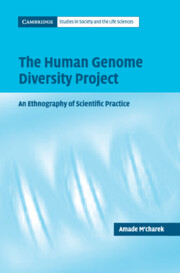Book contents
- Frontmatter
- Contents
- Preface
- 1 Introduction
- 2 Technologies of population: making differences and similarities between Turkish and Dutch males
- 3 Ten chimpanzees in a laboratory: how a human genetic marker may become a good genetic marker for typing chimpanzees
- 4 Naturalization of a reference sequence: Anderson or the mitochondrial Eve of modern genetics
- 5 The traffic in males and other stories on the enactment of the sexes in studies of genetic lineage
- 6 Technologies of similarities and differences, or how to do politics with DNA
- Glossary
- References
- Index
3 - Ten chimpanzees in a laboratory: how a human genetic marker may become a good genetic marker for typing chimpanzees
Published online by Cambridge University Press: 06 July 2010
- Frontmatter
- Contents
- Preface
- 1 Introduction
- 2 Technologies of population: making differences and similarities between Turkish and Dutch males
- 3 Ten chimpanzees in a laboratory: how a human genetic marker may become a good genetic marker for typing chimpanzees
- 4 Naturalization of a reference sequence: Anderson or the mitochondrial Eve of modern genetics
- 5 The traffic in males and other stories on the enactment of the sexes in studies of genetic lineage
- 6 Technologies of similarities and differences, or how to do politics with DNA
- Glossary
- References
- Index
Summary
Introducing the argument
This chapter deals with genetic markers. In the field of population genetics, markers are crucial categories. They are the very objects of comparison between individuals or between populations. This has become clear from Chapter 2. The question in this chapter is, therefore, what is a genetic marker? To answer this, I will treat a marker neither as a quality embodied in the DNA nor as an autonomous category that can be investigated everywhere. Rather, I will “study around it” and examine the socio-technical network of laboratory routines in which it is enacted. Markers, as will become clear, are hybrids, which involve DNA, technologies and ways of aligning these. The argument put forward is that genetic markers are technically and locally invested, and that this quality co-determines their ability to move from one locale to another.
Genetic markers are often presented as innocent tools, as loci present on the DNA that need only the keen eye of technology to make them emerge. Population geneticists have become increasingly aware of the lack of universality of these tools and of their embeddedness in different populations as well as in different laboratory practices. Nevertheless, the dream of genetics is to find universal markers, through trial and error or through large-scale studies. This is, in a way, a quest for the unproblematic tool that will make it possible to focus more on populations and less on the technology at hand.
- Type
- Chapter
- Information
- The Human Genome Diversity ProjectAn Ethnography of Scientific Practice, pp. 56 - 83Publisher: Cambridge University PressPrint publication year: 2005



